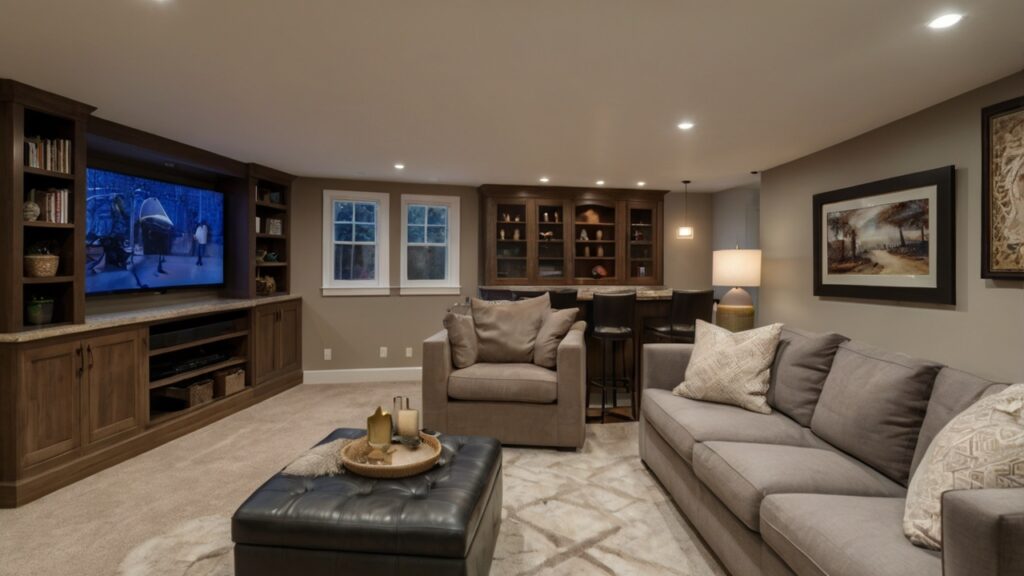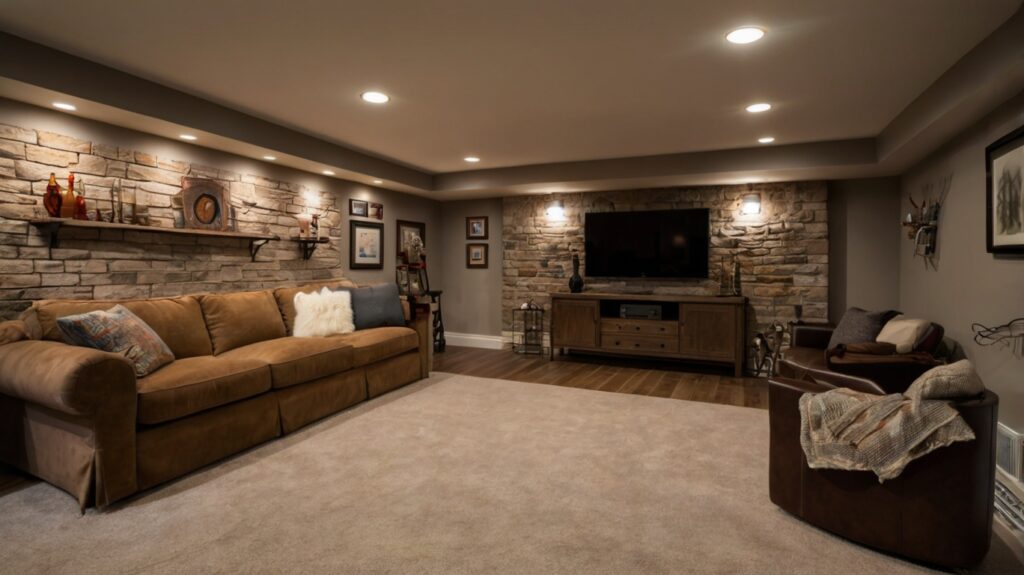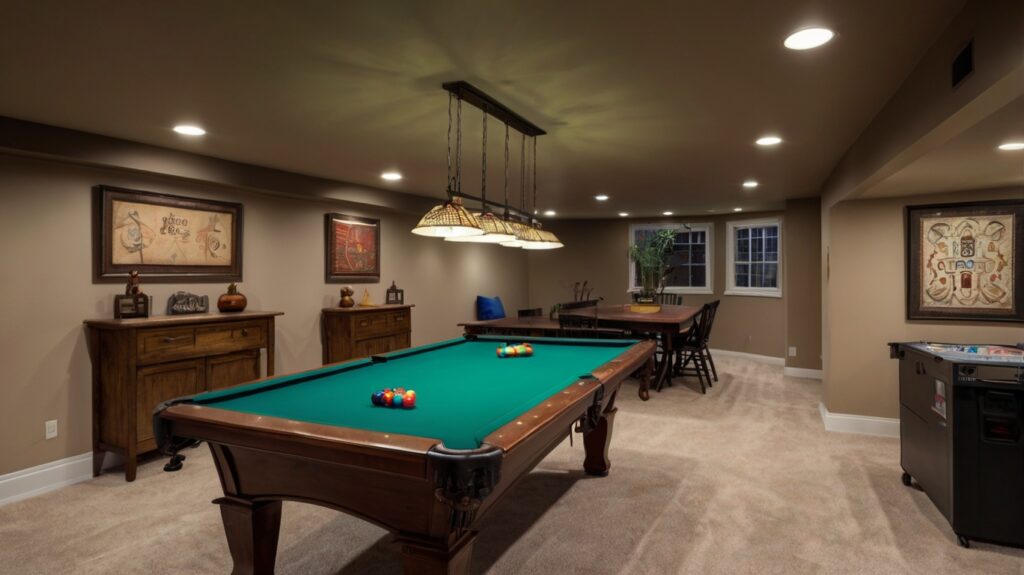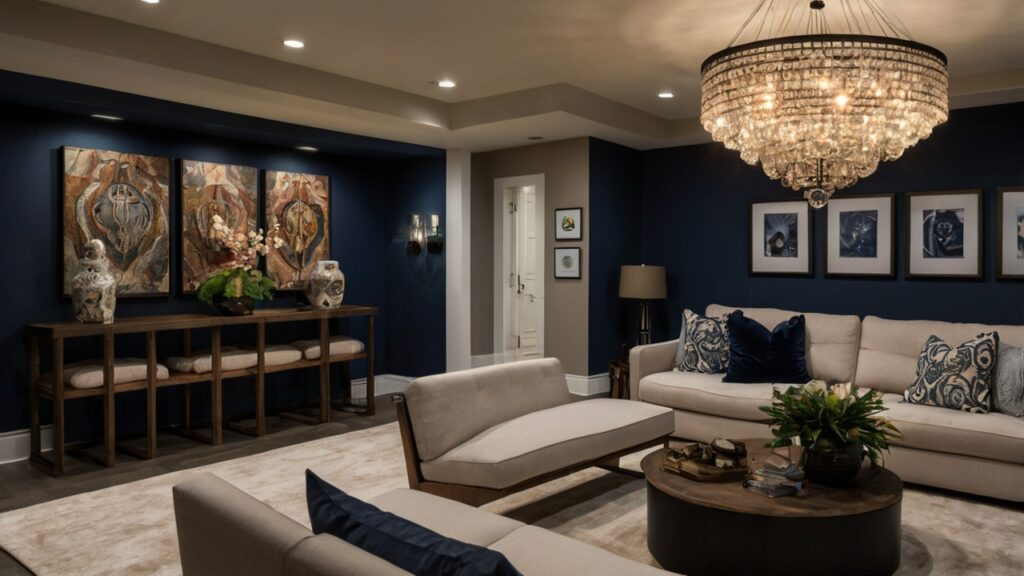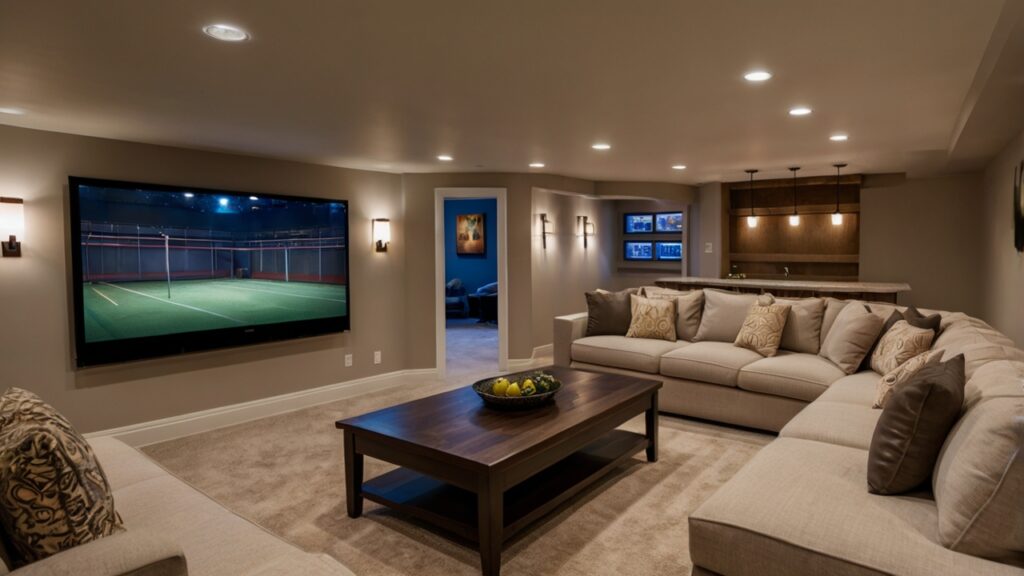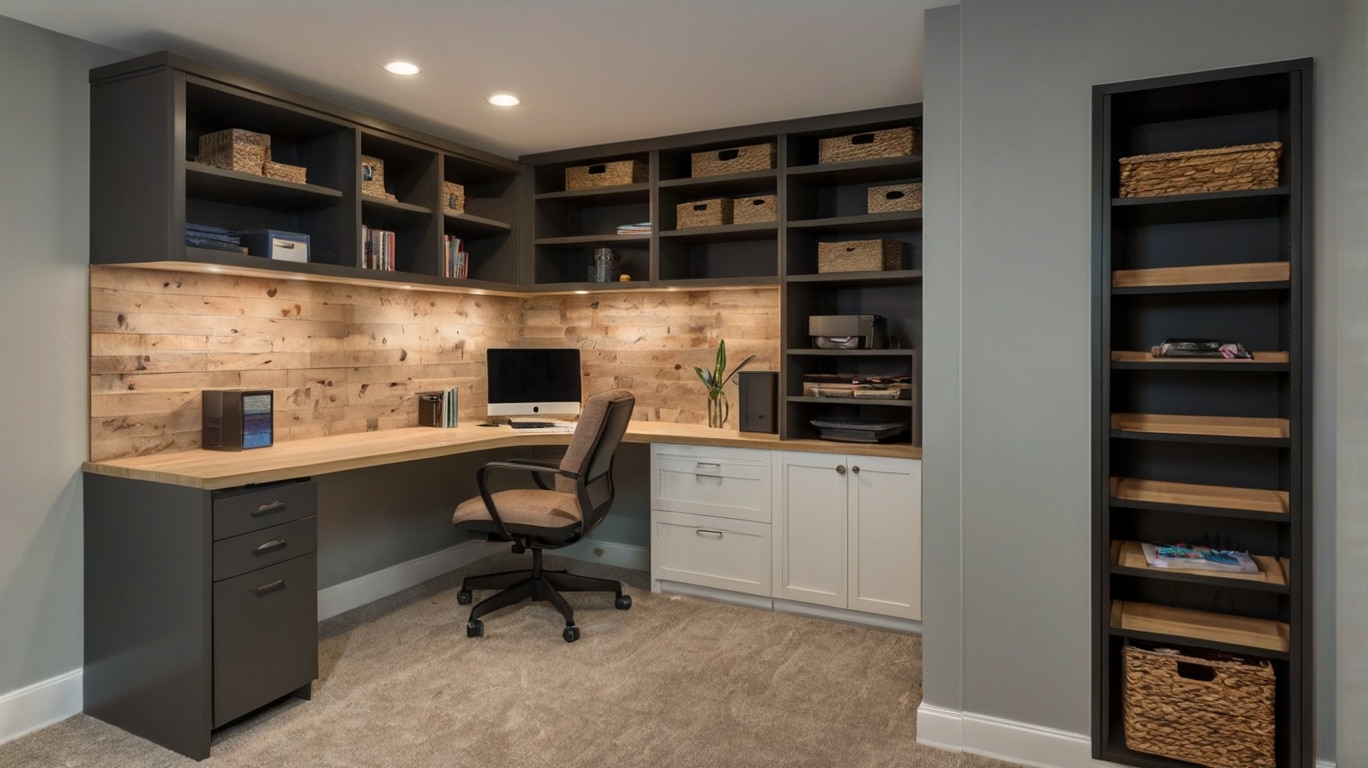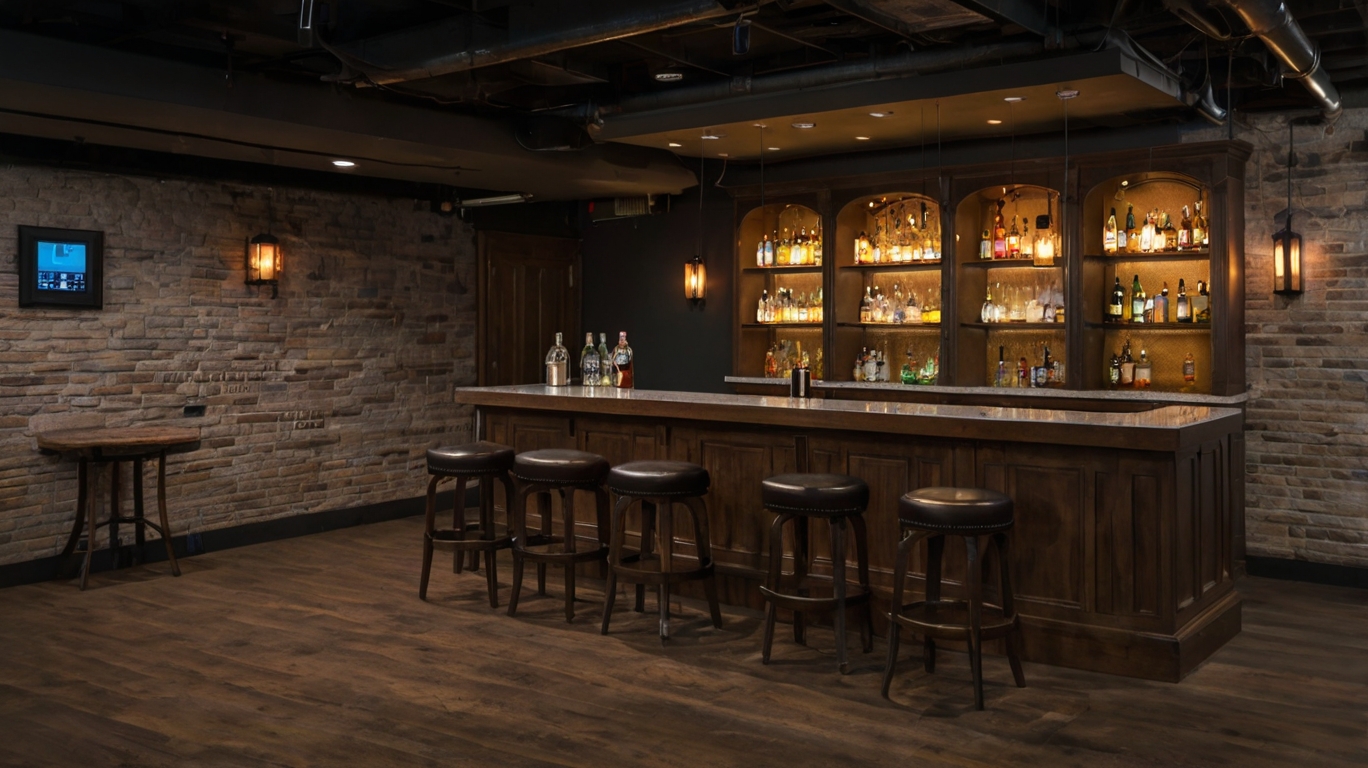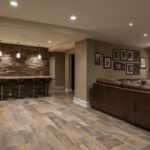
Bright Ideas: Transform Your Space with Creative Basement Lighting Solutions22 min read
When you think of your basement, what comes to mind? For many, it’s a space that’s a bit dark, maybe even a little neglected—a place where old boxes gather dust and where natural light is scarce. But what if I told you that your unfinished basement has the potential to become one of the most inviting, functional areas in your home? The key to unlocking this hidden potential lies in how you light the space.
Lighting is one of the most powerful tools in home design, capable of completely transforming a room’s atmosphere, functionality, and aesthetic. This is especially true for basements, where lighting can often be an afterthought. But with a little creativity and some thoughtful planning, you as homeowners can turn your basement from a dim, underutilized area into a bright, welcoming retreat that adds real value to your home.
Contents
Creative Basement Lighting Solutions
Basements often get a bad rap as dark, dingy spaces are reserved for storage or laundry. However, with the right lighting solutions and professional basement finishing, your basement can be transformed into a vibrant, inviting area that adds significant value and functionality to your home.
Whether you’re renovating or remodeling your basement into a family room, home office, or entertainment hub, lighting plays a crucial role in setting the mood and enhancing the overall design. You’re about to discover how the right lighting can truly transform your basement into a place you and your family will love to spend time in.
Maximize Natural Light
When it comes to transforming an empty bedroom or entire basement into a vibrant, welcoming space, maximizing natural light is a game changer. Natural light not only brightens a room but also creates a more inviting atmosphere, improves mood, and can even make a space feel larger.
Here’s how you can make the most of natural light in your basement.
Enhance Existing Windows
If your basement has windows, start by making the most of them.
- Keep Windows Uncovered: Simple as it sounds, leaving windows uncovered or using sheer curtains can allow more light to filter into the space. Heavy drapes or blinds block light and can make a basement feel even darker.
- Clean Windows Regularly: Dirt and grime on windows can significantly reduce the amount of light that enters. Regular cleaning helps maximize the amount of natural light.
- Opt for Window Films: If privacy is a concern, consider using frosted or patterned window films that allow light through while still obscuring views from the outside.
Consider Adding More Windows
If possible, adding more windows or enlarging existing ones can significantly increase the amount of natural light in your basement.
- Egress Windows: These are required by building codes for bedrooms and other habitable spaces and can be larger than standard windows. They also provide an escape route in case of emergency.
- Window Wells: For basements with below-grade windows, window wells can be installed to allow more light to reach the windows and brighten up the space.
- Skylights or Light Tubes: In some cases, installing skylights or light tubes (which channel light from the roof into your basement) can be an effective way to bring in natural light, even if your basement doesn’t have many windows.
Utilize Reflective Surfaces
Reflective surfaces can help amplify the natural light that enters your basement, making the space feel brighter and more open.
- Mirrors: Strategically placing mirrors on walls can help bounce light around the room. Large mirrors or multiple smaller ones can reflect light and create the illusion of more space.
- Light-Colored Walls and Ceilings: Light-colored walls and ceilings help reflect and diffuse natural light. Consider painting your walls in soft whites, light grays, or pastel shades to enhance the brightness of the space.
- Glossy Finishes: High-gloss finishes on furniture, trim, and cabinetry can also reflect light, adding to the overall brightness of the room.
Optimize Interior Layout
The layout and construction of your basement can impact how natural light is distributed throughout the space.
- Open Floor Plan: An open floor plan allows light to flow more freely through the space. Avoid heavy, bulky furniture that can block light and create dark corners.
- Strategic Placement: Position light-colored furniture and decor near windows to make the most of the available light.
- Use Light-Reflecting Materials: Materials like glass and polished metal can help bounce light around the room and enhance the brightness.
Install Light-Enhancing Elements
Incorporating elements that help distribute and amplify natural light can make a big difference.
- Transom Windows: These are small windows installed above doors or larger windows that allow light to pass between rooms and brighten up areas that might otherwise be dim.
- Glass Doors: Using glass doors or partitions can help light travel through different areas of the basement, creating a more open and airy feel.
- Interior Windows: If structural changes are an option, consider installing interior windows or glass walls between rooms to allow light to flow more freely throughout the space.
Layer Your Lighting
When it comes to lighting your basement, a single light source often isn’t enough to create the ambiance and functionality you’re aiming for. Instead, the secret to a well-lit, inviting basement lies in layering your lighting. By combining different types of lighting, you can achieve a more balanced, versatile, and visually appealing space. Motion sensors can also be integrated as part of advanced lighting control options, enhancing both functionality and convenience.
Here’s a guide to understanding and implementing layered lighting in your basement.
Ambient Lighting
Ambient lighting serves as the foundation of your lighting scheme, providing general illumination throughout the space. It’s essential for ensuring that your basement is well-lit and functional.
- Recessed Lighting: Recessed lights (also known as downlights or can lights) are a popular choice for basements because they offer unobtrusive, even illumination without taking up valuable headroom. They can be strategically placed to eliminate dark corners and provide consistent light across the room.
- Ceiling Fixtures: Flush-mount ceiling lights or chandeliers can offer a stylish alternative to recessed lighting. Choose fixtures that complement the room’s decor and provide adequate illumination for the entire space.
- Track Lighting: Track lighting systems offer flexibility and control, allowing you to direct light exactly where it’s needed. This can be especially useful in larger basements or areas with multiple zones.
Task Lighting
Task lighting is a lamp designed to illuminate specific areas where activities like reading, working, or cooking take place. It provides focused light that enhances functionality and reduces eye strain.
- Desk Lamps: For a basement home office or study area, desk lamps provide targeted light that makes working or studying easier and more comfortable.
- Under-Cabinet Lighting: If your basement includes a kitchenette or wet bar, under-cabinet lighting helps illuminate countertops and workspaces, making food prep and cleanup easier.
- Pendant Lights: Pendant lights can be installed over specific areas, like a game table or bar, to provide focused illumination that enhances functionality and adds a decorative touch.
Accent Lighting
Accent lighting adds depth and visual interest to your basement by highlighting architectural features, artwork, or other focal points. It helps create a layered lighting effect that enhances the overall ambiance of the space.
- Wall Sconces: Wall sconces can be used to highlight artwork, photographs, or architectural details. They add a touch of elegance and can also provide additional ambient light.
- LED Strip Lights: LED strips can be installed along shelves, behind furniture, or under stairs to create a subtle glow that adds dimension and visual interest to the room.
- Spotlights: Use adjustable spotlights to draw attention to specific features or areas, such as a feature wall or a piece of artwork. They can be mounted on ceilings or walls to provide targeted illumination.
Dimmer Switches and Motion Sensors
Incorporating dimmer switches into your lighting design gives you control over the brightness of your lights, allowing you to adjust the ambiance according to your needs and preferences.
- Versatility: Dimmer switches enable you to create different lighting scenarios, from bright, energetic environments for activities to softer, more relaxed lighting for unwinding or entertaining.
- Comfort: By adjusting the light intensity, you can reduce glare and eye strain, creating a more comfortable and enjoyable space.
- Ambiance: Dimmer switches allow you to set the mood for various occasions, whether it’s a cozy movie night, a lively gathering, or a quiet evening.
Lighting Control Systems
For added convenience and flexibility, consider investing in a smart lighting control system. These systems allow you to manage your lighting using a remote control or a connected smartphone app, giving you the ability to adjust lighting levels and switch between different lighting scenarios with ease.
- Automated Lighting: Set schedules or presets for different times of the day or activities, so your lighting adjusts automatically to your needs.
- Voice Control: Some smart lighting systems can be integrated with voice assistants like Alexa or Google Assistant, allowing you to control your lights using voice commands.
- Customization: Customize your lighting settings to create the perfect atmosphere for any occasion, from bright and energetic to soft and relaxing.
Choose the Right Bulbs
Selecting the right bulbs is crucial in achieving the ideal lighting for your basement. The type of bulb you choose impacts not only the brightness and energy efficiency of your space but also the overall ambiance and functionality. Additionally, ensuring that your lights are controlled by a wall switch is important for proper lighting control and compliance with electrical codes.
Here’s a comprehensive guide to help you choose the best bulbs for your bathroom and basement lighting needs.
Understand Different Types of Bulbs
Each type of bulb has its characteristics, advantages, and best uses. Understanding these can help you make the right choice for your basement.
- Incandescent Bulbs: Traditional incandescent bulbs offer a warm, inviting light and are generally inexpensive. However, they are less energy-efficient and have a shorter lifespan compared to newer technologies.
- Halogen Bulbs: A type of incandescent bulb, halogens are more energy-efficient and offer a brighter, whiter light. They are often used for task lighting and accent lighting but can produce significant heat.
- Compact Fluorescent Lamps (CFLs): CFLs are more energy-efficient than incandescent bulbs and have a longer lifespan. They come in various color temperatures and are suitable for general lighting, although they can sometimes take a moment to reach full brightness.
- Light Emitting Diodes (LEDs): LEDs are the most energy-efficient option, with a long lifespan and minimal heat production. They are available in various color temperatures and brightness levels, making them versatile for all types of lighting needs.
- Smart Bulbs: Smart bulbs offer the ability to adjust brightness, and color, and even control the lighting remotely via a smartphone or voice assistant. They can be a great choice for flexible and customizable lighting solutions.
Select the Right Color Temperature
The color temperature of a bulb affects the mood and functionality of the space. Color temperature is measured in Kelvins (K) and determines whether the light appears warm, neutral, or cool.
- Warm White (2700K-3000K): This color temperature provides a soft, warm light that creates a cozy and inviting atmosphere. It’s ideal for living areas, relaxation zones, and spaces where you want to create a comfortable ambiance.
- Neutral White (3500K-4100K): Neutral white light is more balanced and less yellow than warm white. It’s suitable for areas where you need clear, functional lighting, such as home offices, kitchens, and workspaces.
- Cool White (5000K-6500K): Cool white light offers a bright, crisp illumination that mimics daylight. It’s ideal for task lighting and spaces where clarity and focus are important, like workshops or reading areas.
Consider Brightness Levels
Brightness is measured in lumens, not watts. Higher lumens mean brighter light, while lower lumens result in softer light.
- High Lumens: For areas where you need strong, focused lighting, such as workspaces or reading areas, choose bulbs with higher lumens. This ensures sufficient illumination for tasks and activities.
- Moderate Lumens: For general ambient lighting, a moderate level of brightness is typically sufficient. This creates a balanced light that’s comfortable for everyday use.
- Dimmer Compatibility: If you use dimmer switches, ensure that the bulbs you choose are compatible with them. Many LED and CFL bulbs are dimmable, but it’s important to check the specifications.
Choose Energy-Efficient Options
Energy-efficient bulbs can save you money on electricity bills, save money, and are better for the environment.
- LEDs: LED bulbs are the most energy-efficient option, using up to 80% less energy than incandescent bulbs. They also have a longer lifespan, reducing the frequency of replacements.
- CFLs: CFL bulbs are also energy-efficient, using about 70% less energy than incandescent bulbs. They are a good alternative if you prefer a different light quality than LEDs offer.
Evaluate Lifespan, Cost, and Resale Value
Consider the lifespan and cost of the bulbs to determine the best value for your investment.
- Long Lifespan: LEDs have the longest lifespan, often lasting over 25,000 hours. This reduces the need for frequent replacements and overall maintenance.
- Cost vs. Savings: While LEDs and CFLs may have a higher upfront cost compared to incandescent bulbs, their energy savings, and longer lifespan can lead to lower costs over time.
Consider Specialty Bulbs
For specific projects or applications, you might need specialty bulbs that cater to unique lighting needs.
- Decorative Bulbs: If you’re using lighting fixtures for decorative purposes, consider bulbs with unique shapes or finishes to enhance the aesthetic appeal.
- High CRI Bulbs: If accurate color representation is important (e.g., for art studios or areas with detailed tasks), choose bulbs with a high Color Rendering Index (CRI) to ensure true-to-life color illumination.
Incorporate Creative Lighting Fixtures
When it comes to illuminating your basement, choosing creative lighting fixtures can make a significant impact on both the aesthetics and functionality of the space. For instance, a home theater within your basement requires specific lighting to enhance the viewing experience and contribute to the overall usability of the space. Lighting fixtures are not just practical elements; they also serve as design statements that can enhance the overall look and feel of your basement.
Here’s how to incorporate creative lighting fixtures to transform your basement into a stylish and inviting area.
Statement Chandeliers
A statement chandelier can serve as a focal point in your basement, adding a touch of elegance and grandeur.
- Modern Designs: Opt for contemporary chandeliers with sleek lines and geometric shapes to complement modern decor. Materials like chrome, glass, or polished metal can add a sophisticated edge.
- Vintage Charm: For a more classic or vintage look, choose chandeliers with ornate details, such as crystal or antique finishes. These can add a sense of opulence and character to your space.
- Multi-Tiered Chandeliers: If your basement has higher ceilings, consider multi-tiered chandeliers that draw the eye upwards and create a dramatic effect.
Industrial-Style Fixtures
Industrial-style lighting fixtures can add a trendy, urban feel to your basement, making it perfect for modern or loft-inspired designs.
- Exposed Bulbs: Fixtures with exposed bulbs or Edison-style bulbs give an industrial edge and can highlight the raw, structural elements of your basement.
- Metal Accents: Look for fixtures with metal finishes, such as brushed nickel, matte black, or copper. These can enhance the industrial aesthetic and add a touch of rugged charm.
- Pendant Lights: Industrial pendant lights with adjustable cords or chains can be used to create focal points over specific areas, such as a bar or dining table.
Creative Pendant Lights
Pendant lights are versatile fixtures that can be used to add both style and functionality to different areas of your basement.
- Cluster Pendants: Arrange multiple pendant lights in a cluster to create a visually striking display. This works well over dining tables, game areas, or home bars.
- Adjustable Pendants: Choose pendants with adjustable heights to customize the lighting based on the activity or mood. This flexibility allows you to adapt the lighting to different needs and occasions.
- Colorful or Artistic Designs: For a playful or artistic touch, opt for pendants with vibrant colors or unique shapes that reflect your style.
Sconces and Wall Lights
Wall sconces and other wall-mounted fixtures can add warmth and character to your basement, while also providing additional illumination.
- Flanking Fixtures: Place sconces on either side of a focal point, such as a fireplace or piece of artwork, to highlight and frame the area.
- Adjustable Wall Lights: Wall lights with adjustable arms or swivels allow you to direct light exactly where it’s needed, making them perfect for reading nooks or workspaces.
- Up and Down Lights: Sconces with up and down lighting can create a layered effect on your walls, adding depth and texture to the room.
LED Strip Lights
LED strip lights are a versatile and creative option for adding ambient and accent lighting to various parts of your basement.
- Under-Shelf Lighting: Install LED strips under shelves or cabinets to create a subtle glow that enhances the ambiance and highlights the items on display.
- Backlighting: Use LED strips to backlight elements such as mirrors, artwork, or architectural features, adding a dramatic and contemporary touch.
- Cove Lighting: Conceal LED strips in coves or along ceiling perimeters to create indirect lighting that adds warmth and dimension to the space.
Floor and Table Lamps
Floor and table lamps offer additional flexibility and can serve as both functional and decorative elements in your basement.
- Architectural Floor Lamps: Choose floor lamps with sleek, architectural designs that can double as sculptural pieces. These work well in corners or next to seating areas.
- Adjustable Table Lamps: Table lamps with adjustable arms or dimming features provide focused light for tasks or reading, while also adding a stylish accent to tables or sideboards.
- Unique Shades: Opt for lamps with creative shades or bases that reflect your style, adding a touch of individuality to your basement decor.
Address Low Ceilings
Low ceilings in a basement can pose a challenge when it comes to lighting design, as traditional fixtures can make a space feel even more cramped. However, with the right approach, you can enhance the functionality and aesthetics of your basement while overcoming the limitations of low ceilings. Consider using pull chain sockets as an alternative lighting control option for low ceilings, allowing for manual control in spaces that lack traditional light switches.
Here’s how to effectively address low ceilings with creative lighting solutions.
Opt for Flush-Mount Fixtures
Flush-mount fixtures are ideal for rooms in bathrooms with low ceilings because they don’t protrude far from the ceiling, preserving headroom and maintaining a clean look.
- Recessed Lighting: Recessed lights (or can lights) are installed directly into the ceiling, offering a sleek and unobtrusive lighting solution. They provide even illumination without taking up vertical space.
- Flush-Mount Ceiling Lights: Choose low-profile ceiling fixtures with a compact design. Modern flush-mount lights come in various styles, including sleek, minimalistic designs that blend seamlessly with the ceiling.
Use Wall-Mounted Fixtures
When ceiling space is limited, wall-mounted fixtures can provide effective lighting while keeping the ceiling uncluttered.
- Wall Sconces: Wall sconces can add ambient or accent lighting without impacting headroom. Select sconces with upward or downward lighting to enhance the vertical space.
- Swing Arm Lamps: Adjustable wall-mounted swing arm lamps offer focused light for specific areas, such as reading nooks or workspaces, and can be moved as needed.
Incorporate Cove Lighting
Cove lighting involves installing light fixtures or LED strips along the edges of the ceiling, where the ceiling meets the walls. This technique provides indirect lighting that makes the space feel larger and more open.
- LED Strips: Install LED strips in cove spaces or along ceiling perimeters to create a soft, diffuse light that enhances the room’s vertical space without overwhelming the low ceiling.
- Concealed Fixtures: Use concealed cove lighting to provide gentle, ambient light that adds depth and dimension to the room without taking up physical space.
Choose Low-Profile Pendant Lights
If you prefer pendant lighting, opt for designs that are specifically made for low ceilings.
- Short Pendant Lights: Select pendant lights with shorter drop lengths to avoid cluttering the space. These fixtures provide a stylish touch while ensuring you maintain adequate headroom.
- Mini Pendants: Mini pendant lights are a great alternative for low ceilings, offering a compact and stylish option that doesn’t dominate the space.
Implement Optical Illusions
Use lighting techniques that create the illusion of higher ceilings and a more open space.
- Vertical Lighting: Focus on vertical lighting elements, such as tall, slender floor lamps or lighted wall panels, to draw the eye upward and create a sense of height.
- Mirrors and Reflective Surfaces: Position mirrors and reflective surfaces strategically to bounce light around the room, enhancing the perception of space and openness.
- Light Colors: Use light-colored paint and furnishings to create a brighter, more open feel. Reflective surfaces and light-colored walls can help amplify the effect of your lighting.
Key Takeaway
The potential for basement lighting is vast and exciting. Lighting is more than just a practical necessity; it’s a key element in creating atmosphere and enhancing the functionality of a room. Yet, when it comes to basements, it’s easy to default to the simplest options. However, with a bit of creativity and a touch of planning, you can elevate your basement from a forgotten zone into a highlight of your home. Planning and executing a basement lighting project as part of a renovation or a larger remodeling project can ensure that all aspects of the space are optimized for both aesthetics and functionality.
With thoughtful lighting choices, your basement can become a bright, functional, and stylish extension of your home. So, whether you’re planning a full-scale basement remodel, a basement renovation, or just looking to refresh your basement, these creative lighting solutions can help you achieve the perfect balance of form and function.
Ready to illuminate your basement like never before?
Don’t settle for a dim, underused basement—let us help you design a lighting plan that enhances every inch of your space. Contact us today to start your basement remodeling journey and discover how innovative lighting ideas can turn your basement into your new favorite room in the house!





